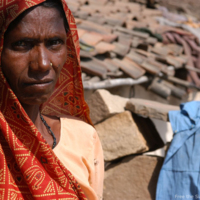
My father never put me through school even though he was healthier than me.1 Now my two sons are both in school, they’re 15 and 8 years old. I got sick a while ago and had to borrow money and that put me in bonded labor, it took me 20 years to pay off that debt. During that time I had to pay for food and my children’s schooling. I’ve been working off my new debt for about 7-8 years. I’m currently in 15,000 rupees in debt and am still working to pay it off. I don’t really know how much I am repaying because there is nothing that tells me how much I pay off each year. My landlord will give me money here and there. If I ever want to work for another landlord I’ll have to give my current landlord the money I receive, about 80 rupees a day.
If I die before my debt is paid my son will inherit the debt. My landlord doesn’t give me any specific amount or time before it’s paid off, I just work continuously and time goes on. My landlord keeps records of my debt on a piece of paper. I paid off 10,000 rupees in 10 years. At that time my landlord gave me food and clothing. I was getting paid 5,000 rupees a year. Now they pay me 8,000 rupees a year but I don’t receive food or clothing. I like that I’m being paid more even though it’s taking me longer to repay my debt. Throughout all of this my landlord remains the same and I call him the owner. He had the same attitude before I was in debt. He treats me respectfully and if he didn’t I wouldn’t work for him. I work for him because my life is not running well.
No one in my community has power but we don’t fear anyone. I don’t know if there are any laws against bonded labor. There are tensions because the younger generation doesn’t respect the dominant people. We have small conflicts here and there. Landlords will sometimes threaten the laborer for not working well. We respect people who run for election, we only request for them to give us something.
I wish to go back to the olden days, when we got things for a cheaper rate. In the olden days we never used to apply chemical fertilizers. Now they’re very strong and food becomes chemicalized. It’s not good enough anymore but we still continue to eat it.
Narrative provided by
Austin Choi-Fitzpatrick, Telling Stories: What Competing Narratives about Slavery tell us about Emancipation (forthcoming)









